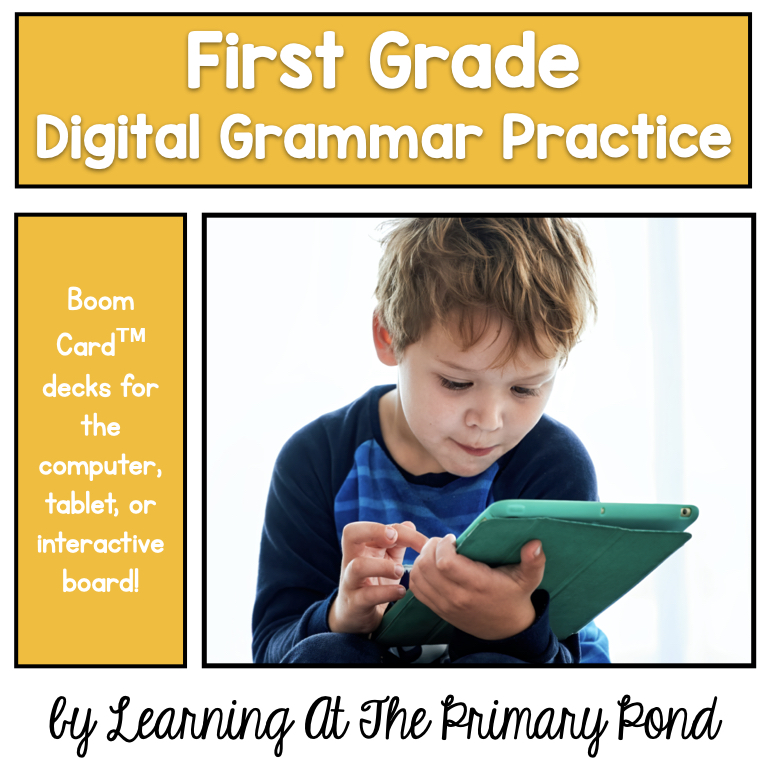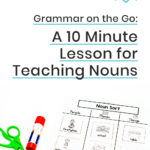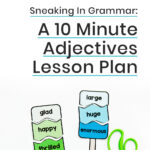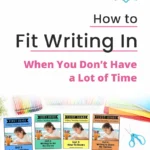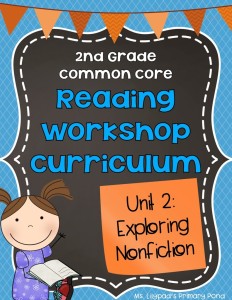Grammar feels like it’s taken a backseat these days.
When I was in school, we worked on grammar every day. We had a (very boring) grammar textbook. It was a pretty big part of our instruction.
In many schools, things have changed since then. And for the better! Traditional grammar instruction has been shown to be ineffective. (You can read more about what type of grammar instruction IS effective in this blog post.)
Anyway, grammar does matter – but sometimes it can be hard to fit in, especially when we need to work on other literacy skills that can feel more pressing.
So how can we make time for grammar instruction when our time is limited? Keep on reading for some simple, do-right-away ideas!

Integrate Grammar Instruction Into Writing Instruction
Working on grammar as you work on writing A) can save time, and B) is a best practice for teaching grammar!
The whole point of teaching grammar is so that kids become strong writers (and speakers). So it only makes sense that at least some grammar instruction take place directly in the context of writing.
For example, let’s say we want to teach our students about adjectives.
If we’re working on narrative writing, we can teach our students how to describe their characters using different adjectives. You might introduce the concept, do a hands-on activity if time permits, brainstorm examples, and then have students add them into their stories. (This could also take place over 2 different lessons.)
If we’re working on opinion writing, we can teach students to use adjectives to describe their topic in a way that helps the reader understand their opinion. (Examples: The movie was funny or peas are disgusting.)
Or, if we’re working on informational writing, we can teach students to use adjectives to teach the reader about their topic. (Examples: Giraffes are very tall or we play basketball with an orange ball.)
In these examples, we’re teaching kids grammar (adjectives), but we’re also teaching them how to improve their writing.
You can learn more about how to integrate grammar instruction into your writing instruction in this blog post.
Try Quick Transition Activities
Kids tend to need a lot of practice and review to really absorb grammar skills. But you may not have time for a grammar lesson each day.
When you want to review a concept but don’t have much time, try one of these quick transition activities:
Transition Activity: What’s the Pattern?
In this activity, you write 3-4 sentences on the board. (Or you can type them and display them using a projector or interactive board – that’s even quicker!)
All of the sentences should be written correctly, and they should all have some type of grammar-based pattern.
Here’s a 2nd grade example:
- Nate’s mom came to the soccer game.
- I think Jabari’s bag is on the hook.
- We couldn’t go to Wendy’s party.
Did you spot the pattern? 🙂 Each of these sentences has a possessive noun in it. (Nate’s mom; Jabaris bag; Wendy’s party)
I like to give students a few moments to read the sentences (or I read them aloud, depending on the ability level of the kids), have some time to think, and then turn and tell a partner what they think the pattern is. Sometimes kids will come up with other patterns that you didn’t even think of – and that can be a great teachable moment, too!
After they’ve identified the pattern, we spend a little bit of time talking about the pattern. In this case, we might review that possessive nouns are formed with an apostrophe and the letter s.
This activity works best with skills you’ve already taught.
Transition Activity: Odd One Out
This activity is similar to “What’s the Pattern?” – but this time, one of the 3-4 sentences has a mistake. Here’s an example:
- We watched the rain, lightning, and hail through the window.
- I bought eggs bread and milk at the store.
- Katelyn, Mike, and Tiana came over to play.
This time, students have to identify the two sentences that have something in common (the first and third sentences, in this example). Then, they identify the “odd one out” – the sentence that is NOT written correctly. They then help me fix the sentence.
I don’t do traditional sentence fixing activities very often. (This blog post explains why.) But I like to use “Odd One Out” every so often because it gives kids CORRECT examples to look at, which then helps them identify the “odd sentence out” as incorrect.
These two transition games can be played with many different skills, and they only take a minute (especially if you type up the sentence ahead of time).
Self-Checking, Interactive Independent Work
Sometimes we save grammar practice for independent work time. That can be great – but what about when students practice independently?
If they do get feedback from us, it happens after the fact. (And students really benefit from receiving real-time feedback.)
We can’t rely solely on independent work time for most of our grammar instruction and practice. It’s just not sufficient.
BUT!
What if you had a way to give students self-checking, interactive independent work? Where there’s audio support, and students immediately find out if their work is correct or incorrect?
That would be great, right?! Students could engage in meaningful practice without having you next to them.
(Huge time saver!!)
And guess what? I’ve created a resource that does just that – interactive grammar games where your students can learn about grammar even if you’re not physically there teaching them.
To learn more about these games, click on the images below to access the Kindergarten, First Grade, and Second Grade decks!
Happy teaching!



